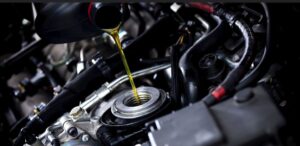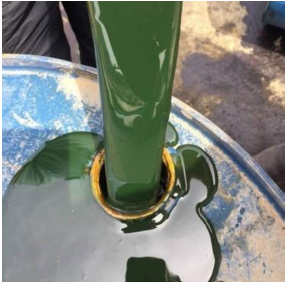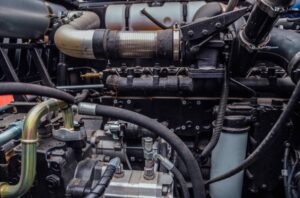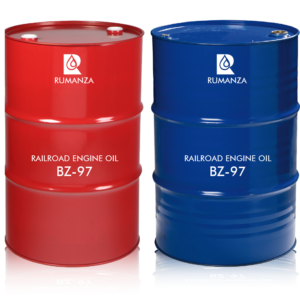Best Railroad Engine Oils in 2025 – Boost Performance & Longevity
The railroad industry is a backbone of global logistics, transporting millions of tons of cargo and passengers daily. Given the immense stress on locomotive engines, selecting the best railroad engine oil is crucial for optimal performance, fuel efficiency, and engine longevity.
In 2025, advancements in lubrication technology have led to high-performance synthetic blends, low-ash formulations, and smart additives that enhance engine protection under extreme conditions. This guide provides an in-depth analysis of the best railroad engine oils, their benefits, drawbacks, and key selection criteria, along with a comparison table for easy decision-making.
We’ll also highlight Rumanza Railroad Engine Oils as a premium choice, backed by cutting-edge technology for superior thermal stability, wear resistance, and extended drain intervals.
Why Railroad Engine Oil Selection is Critical
Railroad diesel engines operate under extreme pressures, high temperatures, and prolonged running hours. The right engine oil must:
✔ Minimize friction & wear – Prevents metal-to-metal contact.
✔ Withstand thermal breakdown – Maintains viscosity under heat.
✔ Prevent sludge & deposits – Keeps engines clean.
✔ Improve fuel economy – Reduces operational costs.
✔ Extend engine lifespan – Lowers maintenance frequency.
Using subpar oil can lead to:
❌ Increased engine wear
❌ Higher fuel consumption
❌ Frequent oil changes & downtime
❌ Risk of engine failure
Key Properties Railroad Engine Oils
Rumanza Railroad Engine Oil BZ-97 is a robust, medium-speed diesel engine crankcase oil with high dispersant properties, effectively suspending combustion and oxidation byproducts. Engineered to maintain cleanliness in critical areas such as the right belt area, valve deck, crankcase, and piston under crowns.
- High dispersant formula for effective byproduct suspension.
- Maintains cleanliness in critical engine areas.
- Specifically designed for medium-speed diesel engines.
- Zinc-free composition, meeting API CF-2 requirements.
1. Viscosity & Viscosity Index (VI)
Why it matters: Determines oil flow at different temperatures.
Best for railroads: SAE 15W-40, 20W-50, or multi-grade oils for varying climates.
High VI oils maintain stability in extreme heat/cold.
2. Thermal & Oxidation Stability
Why it matters: Prevents oil degradation under high heat.
Best oils: Synthetic blends with advanced antioxidants.
3. Anti-Wear Additives (ZDDP, Molybdenum)
Why it matters: Protects engine components from wear.
Best for heavy loads: Oils with high zinc (ZDDP) content.
4. Detergency & Dispersancy
Why it matters: Prevents sludge, soot, and carbon buildup.
Best oils: Formulated with high TBN (Total Base Number).
5. Low SAPS (Sulfated Ash, Phosphorus, Sulfur)
Why it matters: Meets emission regulations (EPA, Euro VI).
Best for eco-compliance: Low-ash synthetic oils.
Rumanza Railroad Engine Oils Specification
Meets API CF-2 specifications, ensuring optimal performance and protection for medium-speed diesel engines in railroad applications.
Typical Properties:
| PARAMETERS | TEST METHOD | UNIT | BZ-97 | |
| SAE Grade | 40 | 20W-40 | ||
| Kinematic Viscosity @ 104°F /40°C | ASTM D-7042 | cSt | 170 | 125 |
| Kinematic Viscosity @ 212°F /100°C | ASTM D-7042 | cSt | 15 | 15.3 |
| Viscosity Index | ASTM D-2270 | – | 90 | 127 |
| SP. Gravity @15°C/ 60°F | ASTM D-4052 | g/cm3 | 0.902 | 0.890 |
| Flash Point (min) | ASTM D-92 | °C | 250 | 238 |
| Pour Point (max) | ASTM D-97 | °C | -15 | -24 |
| TBN | ASTM D-2896 | Mg KOH/g | 13 | 13 |
| CCS, (°C) | ASTM D-5293 | m.Pa.S | N/A | 9100 (-15) |
Top 5 Railroad Engine Oils in 2025 – Detailed Analysis
1. Synthetic High-Performance Railroad Oil
Pros:
✅ Full synthetic base – Superior thermal stability.
✅ Low volatility – Reduces oil consumption.
✅ Extended drain intervals – Saves maintenance costs.
✅ Excellent cold-start performance (–30°C and below).
Cons:
❌ Higher initial cost than conventional oils.
❌ Not all engines may need full synthetic.
Best For: Extreme-temperature operations, high-speed locomotives.
2. Heavy-Duty Diesel Engine Oil
Pros:
✅ High TBN (12-15) – Neutralizes acidic byproducts.
✅ Soot control technology – Keeps engines cleaner.
✅ Improved fuel efficiency – Reduces operational costs.
Cons:
❌ Shorter drain intervals in high-soot conditions.
❌ May not be ideal for cold climates.
Best For: Long-haul freight trains, high-load operations.
3. Multi-Grade Railroad Lubricant (10W-40 / 15W-50)
Pros:
✅ Works in all seasons – Stable in hot & cold climates.
✅ Shear-resistant – Maintains viscosity under stress.
✅ Cost-effective – Balances performance & price.
Cons:
❌ Not as thermally stable as full synthetics.
❌ May require more frequent changes in extreme heat.
Best For: Mixed-fleet operations, regional railroads.
4. Eco-Friendly Low-Ash Engine Oil
Pros:
✅ Meets strict emission norms (EPA Tier 4, Euro VI).
✅ Reduces DPF (Diesel Particulate Filter) clogging.
✅ Longer engine life with fewer deposits.
Cons:
❌ Lower anti-wear protection than high-ZDDP oils.
❌ Higher cost due to advanced formulations.
Best For: Environmentally regulated regions, passenger trains.
Rumanza Railroad Engine Oils – The Premium Choice
Why It Stands Out in 2025:
✅ Advanced synthetic blend – Superior protection in extreme conditions.
✅ High ZDDP content – Reduces engine wear significantly.
✅ Thermal stability up to 300°C – No breakdown under stress.
✅ Fuel-efficient formula – Lowers operational costs.
✅ Extended drain intervals – Reduces downtime.
Cons:
❌ Premium pricing compared to conventional oils.
❌ May be overkill for older, less demanding engines.
Best For: High-performance locomotives, mining & freight trains.
Comparison Table: Best Railroad Engine Oils (2025)
| Feature | Synthetic High-Performance | Heavy-Duty Diesel Oil | Multi-Grade Lubricant | Eco-Friendly Low-Ash | Rumanza Railroad Oil |
|---|---|---|---|---|---|
| Base Oil Type | Full Synthetic | Semi-Synthetic | Mineral/Synthetic Blend | Low-Ash Synthetic | Premium Synthetic Blend |
| Viscosity Grades | 5W-40, 10W-50 | 15W-40, 20W-50 | 10W-40, 15W-50 | 5W-30, 10W-40 | 10W-60, 15W-50 |
| Thermal Stability | Excellent (Up to 320°C) | Good (Up to 280°C) | Moderate (Up to 250°C) | Good (Up to 270°C) | Exceptional (Up to 350°C) |
| Anti-Wear Additives | High ZDDP | Moderate ZDDP | Basic Anti-Wear | Low ZDDP | Ultra-High ZDDP |
| TBN (Total Base No.) | 10-12 | 12-15 | 8-10 | 6-8 | 14-16 |
| Drain Interval | 30,000-50,000 miles | 20,000-30,000 miles | 15,000-25,000 miles | 25,000-40,000 miles | 50,000-70,000 miles |
| Fuel Efficiency | High | Moderate | Moderate | High | Very High |
| Price (Per Gallon) | $$$$ | $$$ | $$ | $$$$ | $$$$$ |
How to Choose the Best Railroad Engine Oil
1. Check OEM Recommendations
Always follow locomotive manufacturer guidelines (GE, EMD, Siemens).
2. Consider Operating Conditions
Extreme heat? → High VI synthetic oils.
Cold climates? → Multi-grade or low-viscosity oils.
Heavy loads? → High-ZDDP, high-TBN oils.
3. Evaluate Drain Intervals
Longer intervals = lower maintenance costs.
4. Compliance with Emission Standards
Low SAPS oils for Tier 4/Stage V engines.
5. Budget vs. Performance Trade-Off
Premium synthetics cost more but save long-term.
Final Verdict – Which Oil is Best for You?
Selecting the best railroad engine oil in 2025 is a balance between performance, durability, and cost-efficiency. Rumanza Railroad Engine Oils lead the market with unmatched thermal stability, wear protection, and extended drain intervals, making them the top choice for high-demand locomotives.
By understanding viscosity requirements, additive packages, and operational needs, rail operators can enhance engine life, reduce downtime, and optimize fuel efficiency.
Upgrade your locomotive’s lubrication today and experience peak performance with the best oils on the market!
FAQs
It depends on the oil type and operating conditions:
Conventional oils: 15,000–25,000 miles
Synthetic blends: 25,000–40,000 miles
Premium synthetics (like Rumanza): 50,000–70,000 miles
Always check oil analysis reports and manufacturer recommendations.
Low SAPS (Sulfated Ash, Phosphorus, Sulfur) oils have reduced ash content, making them eco-friendly and compliant with EPA Tier 4 and Euro VI emission standards. They help prevent DPF (Diesel Particulate Filter) clogging.
ZDDP (Zinc Dialkyl Dithiophosphate) is a critical anti-wear additive that forms a protective layer on engine components, reducing metal-to-metal friction. High-ZDDP oils (like Rumanza’s premium blend) are essential for heavy-load locomotives.
No! Railroad engines endure much higher stress, heat, and soot levels than truck engines. Always use railroad-specific oils with higher TBN (Total Base Number) and thermal stability.

Guide to Gasoline Engine Oils for UAE’s Extreme Climate: Engineering Peak Performance
Gasoline Engine Oils for UAE’s Extreme Climate: Engineering Peak Performance Discover More In the heart of the Arabian Peninsula, the United Arab Emirates stands as a testament to human ambition, with its engineering marvels and endless highways. Yet, this environment of soaring achievement is also one of the most punishing on Earth for machinery. For your vehicle—whether a nimble city sedan, a powerful family SUV, or a high-performance sports car—the UAE’s climate is a relentless adversary. The choice of engine
What are Polyol Ester Oils & Lubricants – Properties & Applications
What are Polyol Ester Oils & Lubricants – Properties & Applications Discover More In the intricate world of industrial machinery, automotive engines, and advanced refrigeration systems, the choice of lubricant is not merely a maintenance task—it’s a critical engineering decision. While conventional mineral oils have served us for over a century, the demands of modern technology require fluids that can perform under extreme pressure, temperature, and environmental stress. This is where synthetic lubricants, specifically Polyol Ester oils, come to the forefront.

Guide to Choosing the Right Lithium Complex Grease in UAE
Guide to Choosing the Right Lithium Complex Grease in UAE for Unbeatable Performance Discover More In the heart of a region defined by its ambition and extreme climate, the machinery that builds and powers the UAE operates under immense pressure. From the towering cranes sculpting Dubai’s skyline to the massive haul trucks in Abu Dhabi’s industrial zones and the relentless conveyor systems in Jebel Ali Port, every moving part is a critical link in the chain of progress. Protecting these

Lithium Grease UAE – Buy Multi-Purpose Lubricant Grease
Lithium Grease UAE – Buy Multi-Purpose Lubricant Grease Discover More In the relentless engine of the United Arab Emirates’ economy—where monumental construction, non-stop logistics, and a climate of extreme heat and abrasive sand are the norm—the battle against friction and corrosion is perpetual. The integrity of a construction crane’s slewing ring, the smooth operation of a delivery fleet’s wheel bearings, and the silent efficiency of a hotel’s HVAC system all hinge on a single, critical decision: the choice of lubricant.

Best CNG Engine Oil in UAE for Cars – Protect Your CNG Engine
Best CNG Engine Oil in UAE for Cars – Protect Your CNG Engine Discover More The automotive landscape in the UAE is undergoing a quiet revolution. As fuel prices fluctuate and environmental consciousness grows, more and more drivers are making the intelligent switch to Compressed Natural Gas (CNG). CNG-powered cars offer significant cost savings on fuel and produce fewer emissions, making them an economically and ecologically sound choice. However, this transition comes with a critical responsibility: understanding that a CNG

Calcium Sulphonate Grease UAE | High-Temperature Grease
Calcium Sulphonate Grease UAE | High-Temperature Grease Discover More Introduction: The Unforgiving Demands of UAE Industry The United Arab Emirates stands as a global titan of industry and infrastructure. From the sprawling metallurgical plants in Mussafah and the massive port operations of Jebel Ali to the relentless pace of construction shaping Dubai’s skyline and the vast logistics hubs of Al Ain, the machinery that powers this nation operates under extreme duress. Soaring ambient temperatures that regularly exceed 45°C, pervasive dust

What is Rubber Process Oil? | Guide to Applications, Benefits, and Selection
What is Rubber Process Oil? | Guide to Applications, Benefits, and Selection Discover More In the sophisticated ecosystem of rubber manufacturing, raw polymers are the canvas, but rubber process oil is the essential medium that brings the masterpiece to life. It is the critical component that transforms rigid, unworkable raw materials into the versatile, durable, and high-performance rubber products that define modern industry and daily convenience. For specialists dedicated to chemical innovation and precision, such as the team at Rumanza Lubricants, the science

Which UAE Lubricants manufacturers is Best for High-Mileage Engines?
Which UAE Lubricants manufacturers is Best for High-Mileage Engines? Discover More The sprawling deserts and bustling metropolises of the United Arab Emirates present a uniquely demanding environment for vehicles, pushing engine lubrication technology to its absolute limits. From the scorching summer heat that can cause conventional oils to thin out and lose protective properties, to the endless stop-start traffic of cities like Dubai and Abu Dhabi that promotes sludge and acidic buildup, our cars endure a severe service regimen unlike

What Vehicles Use Kerasene? A Comprehensive Guide
What Vehicles Use Kerasene? A Comprehensive Guide to Fueling Beyond Gasoline Discover More When we think of vehicle fuel, gasoline and diesel immediately come to mind. They are the lifeblood of our daily commutes, the power behind the trucks that deliver our goods, and the standard by which we measure automotive progress. But venture beyond the everyday, into the realms of high-altitude aviation, rugged agricultural machinery, and groundbreaking space exploration, and you’ll discover a different, equally vital fuel that operates
